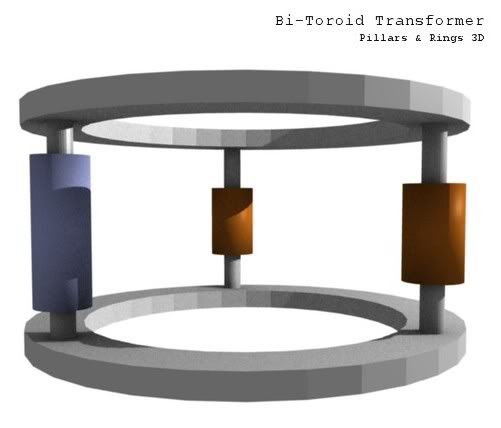10x flux path.
@geotron,
Did you take note of the pop up at 2:07 in Thane's video? It states that:
"Primary flux path reluctance is about 10 times greater then the alternate secondary route".
Increasing the secondary windings might cause BEMF to seep back to the primary. Thane reports a COP of 377% with his secondaries under load, measured only in practically useless milliwatts. A pretty flimsey gizmo, not really good for too much currently. Getting more power out is the central problem. I think your new high permeability core variant II with the 1/4" to 2.5" flux path ratio might help solve the problem.
"Thane Heins" Ottawa University BiTT TRANSFORMER DEMO July 11, 2009 - YouTube
I concieved of your latest configuration independently, and wholeheartedly approve! There may be an even simpler approach:
Consider the largest size Metglass toroid with a primary winding at 6 O'Clock, and two secondaries at 10 and 2, with holes drilled to each side of the primary measured to the 10 to 1 flux path reluctance ratio.
@geotron,
Did you take note of the pop up at 2:07 in Thane's video? It states that:
"Primary flux path reluctance is about 10 times greater then the alternate secondary route".
Increasing the secondary windings might cause BEMF to seep back to the primary. Thane reports a COP of 377% with his secondaries under load, measured only in practically useless milliwatts. A pretty flimsey gizmo, not really good for too much currently. Getting more power out is the central problem. I think your new high permeability core variant II with the 1/4" to 2.5" flux path ratio might help solve the problem.
"Thane Heins" Ottawa University BiTT TRANSFORMER DEMO July 11, 2009 - YouTube
I concieved of your latest configuration independently, and wholeheartedly approve! There may be an even simpler approach:
Consider the largest size Metglass toroid with a primary winding at 6 O'Clock, and two secondaries at 10 and 2, with holes drilled to each side of the primary measured to the 10 to 1 flux path reluctance ratio.









Comment